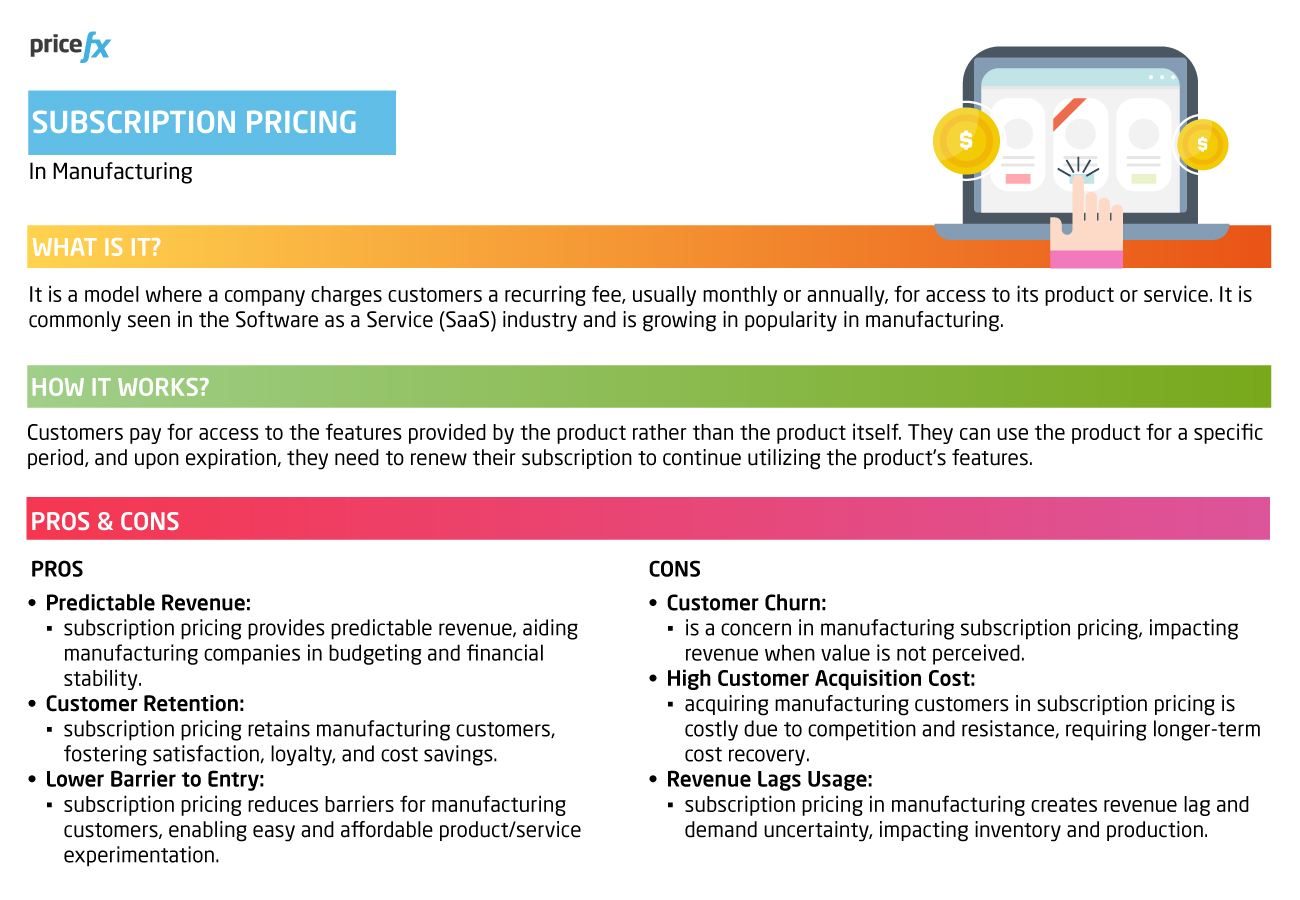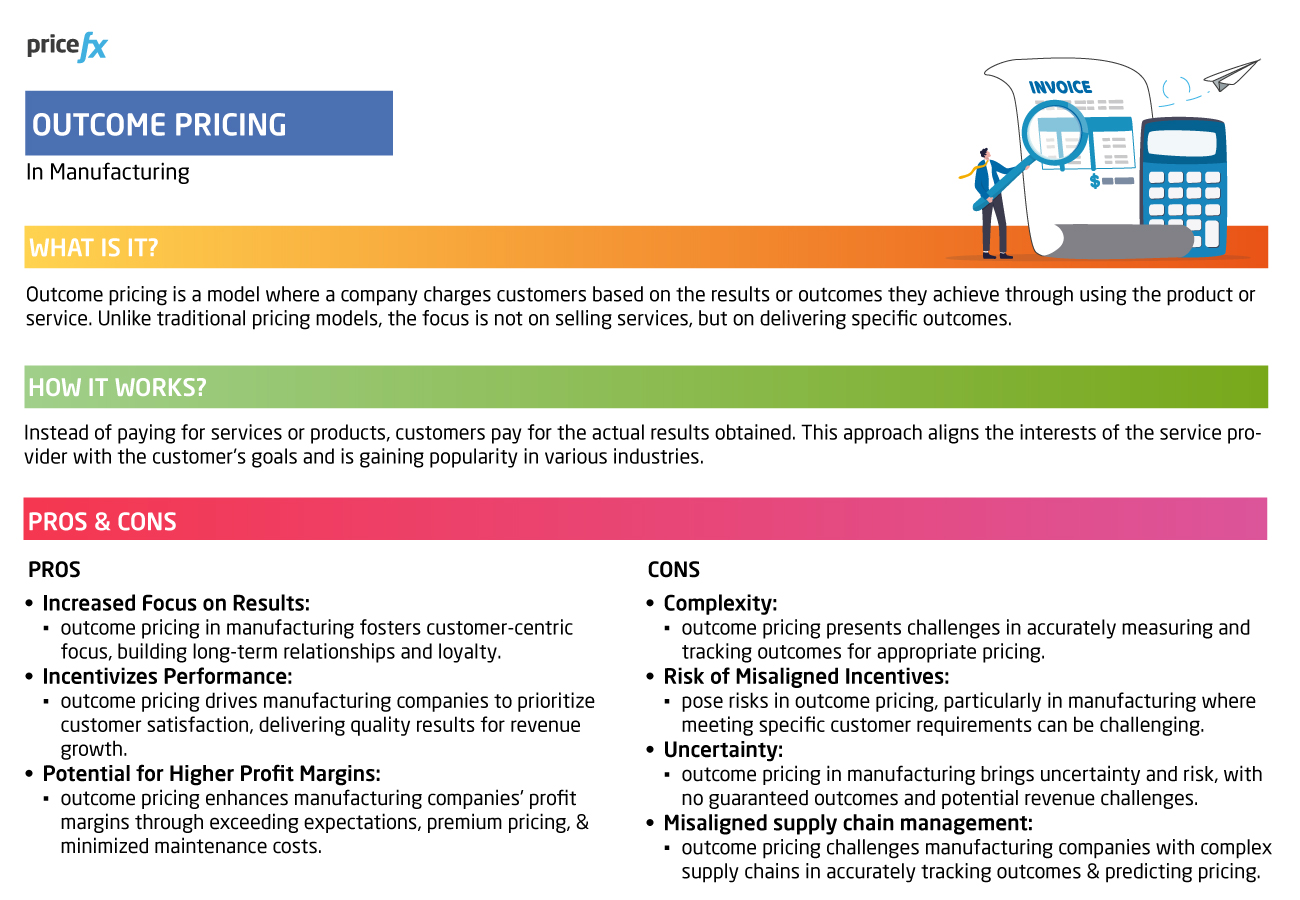Subscription Pricing vs Outcome Pricing: In Manufacturing
May 30th, 2023 | 13 min. read
By Jose Paez
Pricing models play a crucial role in the success of manufacturing companies. The manufacturing industry is constantly evolving, and companies must adopt the right pricing strategy to maintain their competitiveness. When it comes to pricing models, two popular options in the manufacturing industry are Subscription Pricing and Outcome Pricing. Choosing the right pricing model can be challenging but can be crucial to assisting in achieving your business objectives. For instance, you may wish to maintain consistent revenue streams while dealing with uncertain demand. Subscription pricing could be a viable solution to address this challenge, as it provides predictable revenue streams while allowing the manufacturer to focus on delivering products consistently. But for your company’s business model, outcome pricing may be better. How to choose between the two?
At Pricefx, for more than a decade, we have been assisting manufacturing businesses to make transparent, data-informed, real-time pricing decisions. And that technological help allows them to protect their profits, choose and adapt their pricing strategies on the fly in response to changing market conditions and overall evolve into becoming agile and robust pricing organizations.
In this article, we will explore these two pricing models, using examples from the manufacturing industry, discuss their pros and cons, and provide insights on how to choose the right pricing model for your business.
What is Subscription Pricing?
Subscription pricing is a model in which a company charges a customer a recurring fee for access to its product or service. This fee is typically charged monthly or annually. Subscription pricing is prevalent in the ‘Software as a Service’ (SaaS) software industry, but it is becoming increasingly popular in the manufacturing industry.
In this pricing model, the customer pays for access to features that the product delivers rather than access to the product itself.
The customer can use the product for a specific period, and when the period expires, the customer must renew their subscription to continue using features within the product.

Manufacturing Industry Subscription Pricing Examples & Why You Would Choose Them
One of the most prominent examples of subscription pricing in the automotive manufacturing industry. For example, BMW has recently introduced a new service for UK drivers who wish to have a warm seat while driving. This service allows customers to subscribe to the option of having heated seats on a monthly basis. While it is still possible to purchase cars with this feature already installed, this service is intended for those who did not opt for this feature during their original purchase or who acquired a used vehicle without it. With this new service, BMW customers can now experience the comfort of a warm seat during colder days without having to make a full purchase of the option. companies offer subscription-based services.
Another example of subscription pricing in the manufacturing industry is the industrial equipment rental industry. Some companies offer subscription-based services that allow customers to rent equipment for a specific period.
The customer pays a monthly or annual fee for access to the equipment and related services such as maintenance and support. Renting industrial equipment can be costly, and by offering a subscription-based service, the business can provide customers with a more affordable way to access the equipment they need.
This pricing model can also help the business owner generate more predictable revenue streams, as customers are paying a recurring fee for access to the equipment.
Another example that has been around for decades, but it has not necessarily been seen as a subscription, is the concept of extended warranty services or maintenance programs. These are not exactly about accessing features but more about controlling the cost of repairs and scheduled maintenance services. However, these can also offer access to new features in the form of service bulletins for upgrades.
Generally speaking, the subscription-based model can improve customer retention by providing ongoing technical support and other services, which can enhance the customer experience and build customer loyalty. It also allows companies to better plan the cost of ownership of the product or how services will be billed in a more consistent way.
One thing companies hate are surprises, so it helps as a consumer to have a better projection of costs.
The Pros of Subscription Pricing in the Manufacturing Sector
The benefits of subscription pricing in manufacturing center around accurately predicting revenues, maintaining loyal customers, and opening up markets to a larger pool of customers;
- Predictable Revenue: Subscription pricing provides predictable revenue for a manufacturing company. This can help the company plan its budget and make better business decisions. It can also help the company maintain a more stable financial position and avoid cash flow issues.
- Customer Retention: Subscription pricing can help to retain customers in the manufacturing industry. If a customer is satisfied with the product or service, they are likely to renew their subscription, leading to a long-term business relationship. This can reduce the cost of customer acquisition and help to build a loyal customer base.
- Lower Barrier to Entry: Subscription pricing can provide a lower barrier to entry for customers in the manufacturing industry. Customers can use the product or service for an abbreviated period without investing a considerable sum of money upfront. This can make it easier for customers to try out new products or services without a significant financial commitment.
The Cons of Subscription Pricing in the Manufacturing Sector
Subscription pricing also presents some potential drawbacks to manufacturers:
- Customer Churn: Customer churn is a significant challenge in subscription pricing in the manufacturing industry. If a customer is not satisfied with the product or service, they are likely to cancel their subscription, leading to a loss of revenue. This can be particularly challenging when subscription costs are relatively high, as customers may be less likely to continue paying if they do not see value in the product or service.
- High Customer Acquisition Cost: Acquiring new customers in subscription pricing can be expensive in the manufacturing industry. Companies must invest in marketing and sales to attract new customers, which can be particularly challenging when there is significant competition or where customers are more resistant to change. When combined with a large investment up front to set up the infrastructure to support a subscription-based business, companies will have to recoup the investment over a longer period rather than passing the cost to the consumer upfront.
- Revenue Lags Usage: In subscription pricing, revenue lags usage in the manufacturing industry. If a customer uses the product or service less frequently than expected, the company will still receive the same amount of revenue. This can make it difficult for the company to accurately predict revenue and can lead to overestimating demand, which can result in excess inventory or production capacity.
What is Outcome Pricing?
Outcome pricing is a model in which a company charges a customer based on the results or outcomes they achieve by using the product or service.
Outcome pricing is about selling outcomes, not services.
The customer pays for the results they achieve, not the product or service itself.
Outcome pricing is considered to be highly customer-centric as it considers the customer’s barometer for success.
Outcome pricing is becoming increasingly popular in the service industry as it aligns the interests of the service provider with the customer’s goals, incentivizing the service provider to deliver the best possible outcome for the customer. For example, a marketing agency may charge based on the number of leads generated for a client rather than the time spent on the project. This approach motivates the agency to create effective marketing campaigns that drive tangible results for the client.
In the manufacturing industry, outcome pricing is typically applied to equipment and machinery that is sold or leased to customers or based on a set of KPIs (Key Performance Indicators) that apply to the performance of their products.

Manufacturing Industry Examples of Outcome Pricing
In the manufacturing industry, outcome pricing is typically applied to equipment and machinery that is sold or leased to customers. Rather than charging for the equipment itself, the manufacturer charges based on the performance of the equipment, such as uptime, throughput, or energy efficiency. This approach incentivizes the manufacturer to produce high-quality equipment that performs well, as they are directly tied to the customer’s outcomes.
Additionally, this pricing model can benefit customers by shifting some of the risk of equipment performance onto the manufacturer. For example, if a customer is leasing a piece of equipment and it breaks down, the manufacturer is responsible for repairing it and ensuring it continues to perform as expected. This can give customers peace of mind and help them better manage their costs by avoiding unexpected downtime or repair expenses.
An illustration of outcome pricing is the payment method employed by Hitachi Rail, a company that is constructing new trains in Britain. Hitachi’s payment is contingent on the UK train operators completing journeys that satisfy a set of KPIs, such as maintenance, onboard temperature, fleet availability etc. As part of this approach, Hitachi owns and maintains the trains, and the Network Rail System in the United Kingdom compensates Hitachi for providing an “on-time service.”
This model essentially transforms the capital cost of trains into an operational expense, allowing Hitachi to offer “train as a service.” Throughout the life cycle of the trains, frequent interactions between the provider and customer are required, as both parties are invested in achieving the desired outcome. The provider is exposed to high risks but can also enjoy significant rewards.
This pricing strategy is also gaining momentum in other manufacturing sectors as seen with Signify, a lighting manufacturer. Instead of selling bulbs, Signify provides a contract guaranteeing that lights at Amsterdam’s Schiphol airport will never go out. Schiphol has entered into a five-year agreement with no initial investment, and Signify is responsible for maintaining, replacing, and optimizing the installed lights, with Schiphol paying a monthly service charge that includes energy and maintenance expenses.
The Pros of Outcome Pricing in the Manufacturing Sector
The main benefits of outcome pricing for manufacturing companies are:
- Increased Focus on Results: By adopting outcome pricing, manufacturing companies can shift their focus to delivering results that align with their customers’ needs. This can help build a strong relationship with their customers, which can lead to long-term business relationships and customer loyalty.
- Incentivizes Performance: Outcome pricing incentivizes manufacturing companies to perform well and deliver results that meet their customers’ needs. The company is motivated to achieve the desired outcomes for the customer, as it directly impacts the revenue it receives. This approach can help manufacturers prioritize customer satisfaction and focus on delivering high-quality products that meet customer requirements.
- Potential for Higher Profit Margins: Outcome pricing can lead to higher profit margins for manufacturing companies. By delivering results that meet or exceed customer expectations, manufacturers can differentiate themselves from their competitors and charge premium prices. By owning and maintaining the equipment, manufacturers can reduce the risk of unexpected maintenance costs and downtime, leading to improved profitability.
The Cons of Outcome Pricing in the Manufacturing Sector
For manufacturing companies, it is important to acknowledge that implementing outcome pricing can come with several drawbacks;
- Complexity: Outcome pricing can be more complex to implement than other pricing models, which can be challenging for companies. Measuring and tracking outcomes achieved can be a challenging task, and accuracy is essential to ensure that the pricing is appropriate.
- Risk of Misaligned Incentives: If the company and the customer have different goals or expectations, it can lead to conflicts and disputes. This can be particularly problematic in manufacturing, where customer requirements can be quite specific, and the achievement of desired outcomes may be beyond the control of the manufacturer.
- Uncertainty: Outcome pricing can be uncertain for both the company and the customer in the manufacturing industry. There is no guarantee that the desired outcomes will be achieved, which can lead to uncertainty and risk. This can be especially challenging for manufacturers who must invest heavily in materials, labor, and equipment to achieve the desired outcomes, not to mention the uncertainty in outcome pricing as a form of revenue.
- Misaligned supply chain management: Outcome pricing can be particularly challenging for manufacturing companies with complex supply chains, where it can be difficult to track outcomes across the entire value chain. This can make it hard to accurately predict price outcomes.
While outcome pricing can offer benefits for manufacturing companies, including greater alignment with customer needs and improved profitability, it is important to carefully consider the potential drawbacks before implementing this pricing model.
How to Choose the Right Model for Your Manufacturing Business

Choosing the right pricing model for your manufacturing business depends on several factors, including your product or service, your target customers, and your business objectives. Here are some factors to consider when choosing between subscription pricing and outcome pricing:
- Customer Needs: Consider your target customers and their needs. Subscription pricing may be more suitable if your customers require continuous access to your product or service. Outcome pricing may be more suitable if your customers are focused on achieving specific results or outcomes.
- Product or Service: Consider the nature of your product or service. Subscription pricing may be more suitable for products or services that require ongoing access or support, such as equipment rental. Outcome pricing may be more suitable for products or services that deliver specific results or outcomes, such as maintenance and repair services or energy management services.
- Business Objectives: Consider your business objectives. Subscription pricing maybe more suitable if your objective is to build a predictable revenue stream and retain customers over the long term. Outcome pricing could be suitable if your objective is to deliver specific results or outcomes and build a reputation for delivering high-quality results.
- Competition Pricing Models: It is also worthwhile to consider the competitive landscape and the pricing models of your competition, before applying your chosen pricing model.
- Upselling or Cross-Selling Requirements: Another key factor to consider is the potential for upselling or cross-selling. Subscription pricing may allow for greater flexibility in offering additional products or services as add-ons, while outcome pricing may be more limited in this regard.
Whatever pricing strategy your manufacturing organization eventually lands on, having an automated pricing software solution like Pricefx to adapt and change it ‘on the fly’ when market conditions demand will be key to your company’s profitability.
To learn more about what a quality pricing software solution like Pricefx can offer your manufacturing business, check out the handy article below:
Or on the other hand, contact one of the Pricefx pricing software experts today to learn more about how you can get started on your pricing software journey.
Happy Pricing!
